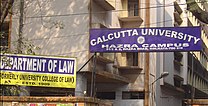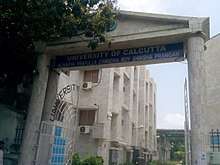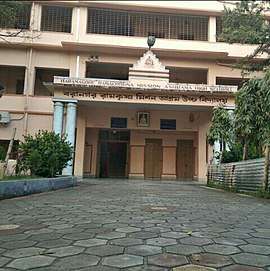University of Calcutta
The University of Calcutta, informally known as Calcutta University (CU), is a collegiate public state university located in Kolkata, West Bengal, India. It was established on 24 January 1857 and was one of the first institutions in Asia to be established as a multidisciplinary, Western-style university. Presently, the university's jurisdiction is limited to a few districts of West Bengal. Within India, it is recognized as a "Five-Star University" and accredited an "A" Grade by the National Assessment and Accreditation Council. The University of Calcutta was awarded the status of "Centre with Potential for Excellence In Particular Area" and "University with potential for excellence" by the University Grants Commission (India) (UGC).
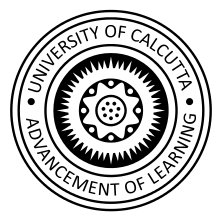 Seal of the University of Calcutta | |
| Motto | Advancement of Learning |
|---|---|
| Type | Public research university |
| Established | 24 January 1857 |
| Chancellor | Jagdeep Dhankhar, (Governor of West Bengal) |
| Vice-Chancellor | Sonali Chakravarti Banerjee[1] |
| Students | 22,520[2] |
| Undergraduates | 3,715[2] |
| Postgraduates | 15,750[2] |
| 1,631[2] | |
| Location | , , 22°34′35″N 88°21′43″E |
| Campus | Urban |
| Acronym | CU |
| Colors | White Sky Blue |
| Nickname | CU |
| Affiliations | UGC, NAAC, AIU, AICTE |
| Sports | University Athletic Club University Rowing Club |
| Website | www |
The university has a total of fourteen campuses spread over the city of Kolkata and its suburbs. As of 2020, 151 colleges and 21 institutes and centres are affiliated with it. The university has secured the seventh position among the universities of India in the Indian University Ranking 2020 list, released by the National Institutional Ranking Framework (NIRF) of the Ministry of Human Resource Development of the Government of India.
Its alumni and faculty include several heads of state, heads of government, social reformers, prominent artists, the only Indian Academy award winner and Dirac medal winner, many Fellows of the Royal Society and five Nobel laureates—the highest number in South Asia—as of 2019. The five Nobel laureates associated with this university are: Ronald Ross. Rabindra Nath Tagore, C. V. Raman, Amartya Sen and Abhijit Vinayak Banerjee. The university has the highest number of students who have cleared the National Eligibility Test The University of Calcutta is a member of the United Nations Academic Impact.
History
Pre-independence
Dr. Fredrick John, the education secretary to the British Government in India, first tendered a proposal to them in London for the establishment of a university in Calcutta, along the lines of London University. In July 1854, the Court of Directors of the East India Company sent a dispatch, known as Wood's despatch, to the Governor General of India in Council, to establish universities in Calcutta (now Kolkata), Madras (now Chennai) and Bombay (now Mumbai).[3][4]
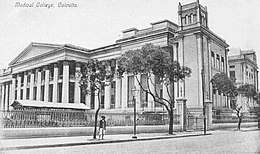
The Calcutta University Act came into force on 24 January 1857, and a 41-member Senate was formed as the policy-making body of the university. The land for the establishment of the university was given by Maharaja Maheshwar Singh Bahadur, who was a Maharaja of Darbhanga. When the university was first established it had a catchment area from Lahore to Rangoon (now in Myanmar), and Ceylon, the largest of any Indian university. Calcutta University became the first university located to the east of the Suez to teach European classics, English literature, European and Indian philosophy and Occidental and Oriental history.[5] The first medical school in Asia, the Calcutta Medical College, was affiliated with the university in 1857.[6] The first college for women in India, Bethune College, is affiliated with the university.[7] From 1836 to 1890, Government Science College, Jabalpur, the first Indian science college, was affiliated with the University of Calcutta.[8] The first university library began functioning in the 1870s. Joddu Nath Bose and Bankim Chandra Chattopadhyay became the first graduates of the university in 1858, and Dr. Kadambini Ganguly and Chandramukhi Basu were the first Indian female graduates in 1882.[9][10][11] The first chancellor and vice-chancellor of the Calcutta University were Governor General Lord Canning and Chief Justice of the Supreme Court, Sir William Colvile, respectively. Ashutosh Mukherjee was the vice-chancellor for four consecutive two-year terms (1906–1914) and a fifth two-year term in 1921–23.[3][12][13]
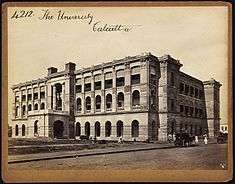
Initially, the university was only an affiliating and examining body. All the academic and teaching work was done in constituent colleges, which were the Presidency College (now called Presidency University), the Sanskrit College and the Bengal Engineering College (now called Indian Institute of Engineering Science and Technology). During that period, the Senate meetings were held in the Council Room of the Calcutta Medical College and Hospital and at the private residence of the vice-chancellor. The faculty councils generally met at the residences of the presidents of the faculties concerned, in the Civil Engineering College or in the Writers' Building. Because of the lack of space, university examinations were held in the Kolkata Town Hall and at other locations like Maidan park using tents.
In 1866, a grant of ₹81,600 (US$1,100) for the site and ₹170,561 (US$2,400) was sanctioned to construct the new building on College Street. It opened in 1873 and was called Senate House. It had meeting halls for the Senate, a chamber for the vice-chancellor, the office of the registrar, examination rooms and lecture halls. In 1904, postgraduate teaching and research began at the university, which led to an increase in the number of students and candidates. After almost sixty years, a second building, known as the Darbhanga Building, was erected in 1912 with a donation of ₹2.5 lakh (US$3,500) from Maharaja Maheshwar Singh Bahadur. It housed the University Law College, its library and some university offices and afforded space to hold university examinations on its top floor. In the same year, the Government of British India granted a sum of Rs 8 lakh for the acquisition of a market, Madhab Babu’s Bazar, situated adjacent to the Senate House, and construction of a new building for the teaching departments began. It opened in 1926, and was later named the Asutosh Building, after Asutosh Mukherjee, vice-chancellor of the university in 1906-14. Between 1912 and 1914, Taraknath Palit and Rash Behari Ghosh, two eminent lawyers, donated assets totalling ₹25 lakh (US$35,000), and founded the University College of Science at 92, Upper Circular Road (currently called Acharya Prafulla Chandra Road).[14]
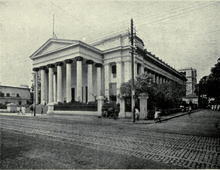
Post-independence
Before the partition of India, twenty-seven colleges from East Bengal (now Bangladesh) were affiliated with the university. In 1951, the Government of West Bengal passed the Calcutta University Act, which substituted the earlier act of 1904 and ensured a democratic structure for the University. The West Bengal Secondary Education Act was passed in the same year linking the university with the school leaving examination. Gradually the requirements of the university grew, and the Senate House was becoming incapable of handling them. After the centenary of Calcutta University, the building was demolished to make space for a more utilitarian building. In 1957, the university's centenary year, it received a grant of ₹1 crore (equivalent to ₹81 crore or US$11 million in 2019) from the University Grants Commission, which aided with the construction of the Centenary Building on the College Street campus and the Law College Building on Hazra Road. The Economics Department got its own building in 1958 near Barrackpore Trunk Road. The Goenka Hospital Diagnostic Research Centre for the University College of Medicine was opened in 1965 to provide medical care to the university community. Until 1960, Senate House was one of the city's most prominent landmarks. In 1968, the Centenary Building opened on the former location of the Senate House. Currently, it houses the Central Library, the Asutosh Museum of Indian Art, the centenary auditorium and a number of university offices. By the mid-1970s, it had become one of the largest universities in the world, with 13 colleges under its direct control and more than 150 affiliated colleges, as well as 16 postgraduate faculties.[15] In the year 2001, the University of Calcutta was awarded the 'Five Star' status in the first cycle of the University's accreditation by the National Assessment and Accreditation Council (NAAC). In 2009 and 2017, the NAAC awarded its highest grade of 'A' to the University of Calcutta in the second and third cycle of the University's accreditation. In 2019, the university's central library and 40 departmental libraries were opened to the public. They have over one million books and more than 200,000 journals, proceedings and manuscripts.[16][17][14]
Seal
The seal has changed multiple times over the years. The current university seal is the modified version of the sixth seal. The motto Advancement of Learning has remained the same through the seal's transitions.[18]
Campuses
The university has a total of 14 campuses spread over the city of Kolkata and its suburbs. They are referred to as Sikhsa Prangan, which in Bangla means education premises. Major campuses include the Central Campus (Ashutosh Shiksha Prangan) on College Street, Rashbehari Shiksha Prangan or Science College in Rajabazar, Taraknath Palit Shiksha Prangan in Ballygunge and Sahid Khudiram Siksha Prangan in Alipore.[19] Other campuses include the Hazra Road Campus, the University Press and Book Depot, the B. T. Road Campus, the Viharilal College of Home Science Campus, the University Health Service, the Haringhata Campus, the Dhakuria Lakes (University Rowing Club) and the University Ground and Tent at Maidan.[20]
Asutosh Siksha Prangan
Asutosh Siksha Prangan (commonly called the College Street Campus) is the university's main campus where the administrative work is done. Located on College Street, it is spread over an area of 2.7 acres (1.1 ha). It houses the Arts and Language department, administrative offices, a museum, the central library, an auditorium etc.[21][22] Senate House was the first university building situated on this campus; it opened in 1872. In 1960, it was demolished to make way for a larger building, the Centenary Building, which opened in 1968. The Darbhanga Building and the Asutosh Building are the two other buildings opened in 1921 and 1926, respectively.[14]
Rashbehari Siksha Prangan
Rashbehari Siksha Prangan (also known as University College of Science, Technology and Agriculture, or more commonly Rajabazar Science College), is located on Acharya Prafulla Chandra Road in Rajabazar. Established in 1914,[23] houses several scientific and technological departments, including pure and applied chemistry, pure and applied physics, radio physics, applied mathematics, psychology, physiology, biophysics and molecular biology, and others.[24][25]
Taraknath Palit Siksha Prangan
Taraknath Palit Siksha Prangan (also known as University College of Science or commonly Ballygunge Science College) on Ballygunge Circular Road in the southern part of the city, houses the departments of agriculture, anthropology, biochemistry, microbiology, botany, genetics, statistics, zoology, neuroscience, marine science, biotechnology, and most notably geology, among others.[24] It also houses S. N. Pradhan Centre For Neurosciences and the Institute of Agricultural Science.[26]
Sahid Khudiram Siksha Prangan
Sahid Khudiram Siksha Prangan, commonly known as Alipore Campus, located at Alipore is the humanities campus of the university. The departments of History, Ancient Indian History and Culture, Islamic History and Culture, South and Southeast Asian Studies, Archaeology, Political Science, Business Management are and Museology are situated on this campus.[27]
Technology Campus
The Technology Campus, also nown as the Tech Camps, is the newest on the university. It brings together the three engineering and technical departments: the Department of Computer Science and Engineering, the A.K.C. School of Information Technology and the Department of Applied Optics and Photonics), in Sector 3, JD Block, Salt Lake.[23][28][29]
Administration
The university is governed by a board of administrative officers, which include the Vice-Chancellor, Pro-Vice-Chancellor for Academic Affairs, Pro-Vice-Chancellor for Business Affairs and Finance, the Registrar, the University Librarian, the Inspector of Colleges, the System Manager and 35 others. They monitor and ensure the smooth operation of the university and its affiliated colleges and the university's funding.[30]
Finances
The university is funded by the University Grants Commission, the Government of West Bengal, other agencies for various research works and by the university's own initiatives like fees, sales proceeds, publications, service charges generated from endowment funds etc.[31][32]
Affiliated Colleges
As of 2020, 151 colleges and 21 institutes and centres are affiliated with the university.[33][34][35]
Some of the earliest affiliated colleges include:[36]
- Gurudas College
- Girls College
- Dum Dum Motijheel College
- Narasinha Dutt College
- Dinabandhu Mahavidyalay
- Rishi Bankim Chandra College
- Gobardanga Hindu College
- Ramkrishna Mission Vidyamandir
- Asutosh College
- Lady Brabourne College
- Uluberia College
- Surendranath College
- Vijaygarh Jyotish Ray College
- Ramsaday College
- South Calcutta Girls' College
- Basirhat College
- Seth Anandram Jaipuria College
- Women's Christian College
- Charuchandra College
- Scottish Church College
- Bangabasi College
- Presidency College
- Sanskrit College
- City College
- St. Xavier's College
- Bethune College
- Vidyasagar College
Academics
Admission
For undergraduate courses—Arts (BA), Commerce (B.Com) and Science (B.Sc) streams (except engineering courses)—one can apply directly for multiple courses based on their Higher Secondary School Certificate examination or any equivalent exam results. Students are shortlisted according to their marks and the number of seats available. For some departments, entrance exams may take place at the sole discretion of the head of the department. Anyone can apply within five years of passing the Higher Secondary Examination.[37] For engineering courses, admission is based on the West Bengal Joint Entrance Examination (WBJEE) rankings.[38][39] While, for postgraduate courses and doctoral degree courses, one has to take an entrance exam/written test given by the university or any national level exam related to the subject, held by the University Grants Commission. A merit list is prepared on the basis of the results of the exams.[40][41][42]
Research
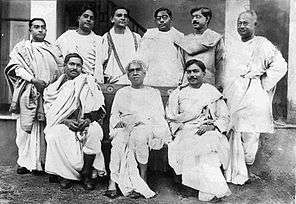
Undergraduates may enroll for a three or a four-year program in Engineering. Students choose a major when they enter the university, and cannot change it unless they opt later for the university's professional or self-financed postgraduate programs. Science and business disciplines are in high demand, largely in anticipation of better employment prospects. Most programs are organized on an annual basis, though some programs are semester dependent. Most departments offer masters programs of a year or a few years' duration. Research is conducted in specialized institutes as well as individual departments, many of which have doctoral programs.[35]
The University of Calcutta has the largest research center, which started from the 100th Science Congress of India in January 2013. This is the Center for Research in Nanoscience and Nanotechnology (CRNN) on the Technology Campus of CU at Salt Lake, West Bengal.[43] The university has 18 research centres, 710 teachers, 3000 non-teaching staff and 11,000 post-graduate students.[2]

Libraries
The central library at the Asutosh Siksha Prangan was started around the 1870s.[44] Apart from 39 departmental libraries, it has a central library, two campus libraries, and two libraries at the advanced centers spread across the seven campuses. Students of affiliated colleges can also access the central library. The university library has over 10 million books and more than 200,000 bound journals, proceedings, manuscripts, and patents.[45]
Publishing
The university has its own publishing house called University Press and Publications along with a book depot, which was established in the 20th century. It publishes textbooks, treatises, journals and confidential papers for all the examinations conducted by the university. It also publishes the journal The Calcutta Review, which is one of the oldest Asian university journals. The Calcutta Review was established by Sir John Kaye in May 1844. It has been issued biannually since 1913.[46][47][48]
Rankings
| University and college rankings | |
|---|---|
| General – international | |
| QS (World) (2020)[49] | 801-1000 |
| QS (Asia) (2020)[50] | 139 |
| QS (BRICS) (2019)[51] | 68 |
| General – India | |
| NIRF (Overall) (2020)[52] | 11 |
| NIRF (Universities) (2020)[53] | 7 |
| The Week (Universities) (2019)[54] | 9 |
| Outlook India (Universities) (2019)[55] | 14 |
Internationally, the University of Calcutta was ranked 801–1000 in the QS World University Rankings of 2020.[49] The same rankings ranked it 139 in Asia[50] and 68 among BRICS nations.[51]
In India, the University of Calcutta was ranked 11th overall by the National Institutional Ranking Framework (NIRF) in 2020[52] and seventh among universities.[53]
Accreditation and recognition
In 2001, the University of Calcutta was awarded "Five Star" status in the first cycle of the university's accreditation by the National Assessment and Accreditation Council (NAAC). In 2009 and 2017, NAAC awarded its highest grade of 'A' to the University of Calcutta in the second and third cycle of the University's accreditation.[56] The University Grants Commission (UGC) recognized the University of Calcutta as a "University with Potential for Excellence", on 8 December 2005.[57][58] It was also awarded the status of "Centre with Potential for Excellence In Particular Area" in Electro-Physiological and Neuro-imaging studies including mathematical modeling.[59][60] The Manuscript Library at the University has also been designated as a "Manuscript Conservation Centre" under the National Mission for Manuscripts, which was established in 2003.[61][62] The university has the highest number of students who have cleared the doctoral entrance eligibility exam, known as National Eligibility Test, in Natural Science and Arts to become eligible to pursue research with a full scholarship awarded by the Government of India.[63] The university is a member of the United Nations Academic Impact initiative.[64]
Faculties and departments
The university has 65 departments organized into eight faculties: agriculture, arts, commerce, social welfare and business management, education, journalism and library science, engineering and technology, fine arts, music and home science, law and science.[35]
The Institute of Agricultural Science offers postgraduate courses in: agricultural chemistry & soil science, agronomy, horticulture, plant physiology, genetics & plant breeding and seed science & technology.[65] The College of Agriculture was founded by Professor Pabitra Kumar Sen, who was the Khaira Professor of Agriculture in the early 1950s.[66] The Faculty of Arts consists of the departments of Ancient Indian History and Culture, archaeology, anthropology, Arabic and Persian, Bengali, language and literature, comparative Indian literature, creative writing, classics, demography, economics, ethnic studies, English language and literature, Hindi, history, linguistics, museology, Pali, philosophy, psychology, political science, public policy and administration, sociology, Sanskrit, South and South-East Asian Studies, theater and drama, gender and women's studies.[35] The Faculty of Education, Journalism, and Library Science consists of three departments that offer courses on education, journalism and mass communication, and library and information science.[35] The Faculty of Engineering and Technology consists of the departments of applied optics and photonics, applied physics, chemical engineering, chemical technology, computer science and engineering, information technology, polymer science and technology, petroleum engineering, radiophysics and electronics, Jute And Fibre Technology. The Department of Home Science offers courses on subjects such as food and nutrition, human development, and home science.[35] The Faculty of Law was established in January 1909 as the University College of Law. It was granted status as the university's department of law in February 1996. This campus is popularly known as Hazra Law College. The faculty has many luminaries associated with it, including Rajendra Prasad, Rashbehari Ghose, and Chittaranjan Das.[67] Faculty of Science has twenty departments. It offers courses on traditional science subjects.[35]
Student life
Student residences
Most of the affiliated undergraduate colleges located in the city have their own student hostels. The university has 17 hostels, of which eight (two for undergraduates and six for post graduates) are for women. A total of 13 hostels are for paying guest students located across the city.[68]
Honoris Causa
Vice-chancellors
List of vice-chancellors of the university:[69]
- James William Colvile, 1857–1859
- William Ritchie, 1859–1862
- Claudius James Erskine, 1862–1863
- Henry Sumner Maine, 1863–1867
- W. S. Seton-Karr, 1867–1869
- Edward Clive Bayley, 1869–1875
- Arthur Hobhouse, 1875–1877
- William Markby, 1877–1878
- Alexander Arbuthnot, 1878–1880
- Arthur Wilson, 1880–1884
- H. J. Reynolds, 1883–1886
- C. P. Ilbert, 1886
- William Wilson Hunter, 1886–1887
- William Comer Petheram, 1887–1889
- Gooroodas Banerjee, 1890–1892
- Jones Quain Pigot, 1893
- Alfred Woodley Croft, 1893–1896
- E. J. Trevelyan, 1897–1898
- Francis William Maclean, 1898–1900
- Thomas Raleigh, 1900–1904
- Alexander Pedler, 1904–1906
- Asutosh Mookerjee, 1906–1914
- Devaprasad Sarvadhikary, 1914–1918
- Lancelot Sanderson, 1918–1919
- Nilratan Sircar, 1919–1921
- Asutosh Mookerjee, 1921–1923 (second term)
- Bhupendra Nath Bose, 1923–1924
- William Ewart Greaves, 1924–1926
- Jadunath Sarkar, 1926–1928
- W. S. Urquhart, 1928–1930
- Hassan Suhrawardy, 1930–1934
- Syama Prasad Mookerjee, 1934–1938
- Sir Azizul Huque, 1938–1942
- Bidhan Chandra Roy, 1942–1944
- Radhabinod Pal, 1944–1946
- Pramathanath Banerjee, 1946–1949
- Charuchandra Biswas, 1949–1950
- Sambhunath Banerjee, 1950–1954
- Jnan Chandra Ghosh, 1954–1955
- Nirmal Kumar Sidhanta, 1955–1960
- Subodh Mitra, 1960–1961
- Surajit Chandra Lahiri, 1962
- Bidhubhushan Malik, 1962–1968
- S. N. Sen, 1968–1976
- Sushil Kumar Mukherjee, 1976–1979
- Ramendra Kumar Podder, 1979–1983
- Santosh Bhattacharyya, 1983–1987
- Bhaskarananda Ray Chaudhuri, 1987–1991
- Rathindra Narayan Basu, 1991–1999
- Asis Kumar Banerjee, 1999–2008
- Suranjan Das, 2008–2015
- Sugata Marjit, 2015–2016
- Ashutosh Ghosh, 2016–2017[70]
- Sonali Chakravarti Banerjee, 2017–[71]
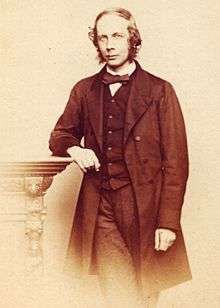 Because of his work on the comparative-historical evolution of legal and political systems, the fourth vice-chancellor, Sir Henry Maine, is widely regarded as a founding figure in the sociology of law.
Because of his work on the comparative-historical evolution of legal and political systems, the fourth vice-chancellor, Sir Henry Maine, is widely regarded as a founding figure in the sociology of law.- During the tenure of Vice-Chancellor Sir Asutosh Mookerjee, the university underwent a significant expansion.
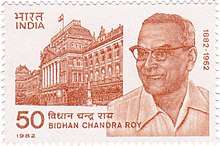 Dr. Bidhan Chandra Roy, who served as a vice-chancellor, was an eminent physician, administrator, and freedom fighter, whose birth date is celebrated as National Doctors' Day in India. As the second chief minister, he established several institutions and five cities in West Bengal.
Dr. Bidhan Chandra Roy, who served as a vice-chancellor, was an eminent physician, administrator, and freedom fighter, whose birth date is celebrated as National Doctors' Day in India. As the second chief minister, he established several institutions and five cities in West Bengal.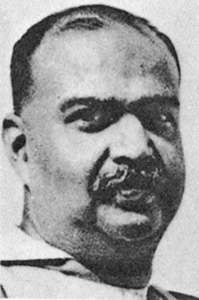 Shyma Prasad Mukherjeee, the youngest vice-chancellor of the university, finance minister of undivided Bengal, and first minister of commerce and industry of independent India.
Shyma Prasad Mukherjeee, the youngest vice-chancellor of the university, finance minister of undivided Bengal, and first minister of commerce and industry of independent India.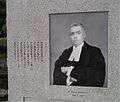 Justice Radhabinod Pal, who served as vice-chancellor, went on to be the sole dissenting judge in the International Military Tribunal for the Far East's trials of Japanese war crimes committed during World War II.
Justice Radhabinod Pal, who served as vice-chancellor, went on to be the sole dissenting judge in the International Military Tribunal for the Far East's trials of Japanese war crimes committed during World War II.
Notable alumni
The university has produced many scientists, engineers, world leaders and Nobel laureates and teachers. As the oldest university of Bengal and India, it attracted students from diverse walks of life. Nobel laureates who either studied or worked there include: Rabindranath Tagore, Chandrasekhara Venkata Raman, Ronald Ross, Amartya Sen and Abhijit Banerjee.[72] The Academy Award winning director Satyajit Ray was an alumnus of the university as was the composer of the national song of India, Bankim Chandra Chattopadhyay. Some of the industrialists who studied at the university include: Sir Rajen Mookerjee, Rama Prasad Goenka, Lakshmi Mittal, Vinay Maloo and Aditya Birla. Notable scientists and mathematicians associated with the university include: Jagadish Chandra Bose, Prafulla Chandra Ray, Meghnad Saha, Anil Kumar Gain, Satyendra Nath Bose and Ashoke Sen.[73]
A nationalist leader and former president of the Indian National Congress, co-founder of the Indian National Army, and head of state of the Provisional Government of Free India, Netaji Subhas Chandra Bose also spent some time at the university. Other presidents of the Indian National Congress include: Womesh Chandra Bonnerjee, Surendranath Banerjee, Anandamohan Bose, Romesh Chunder Dutt, Bhupendra Nath Bose and Madan Mohan Malaviya. Malaviya was also the founder of the Banaras Hindu University. Among the presidents of India associated with this university are: Rajendra Prasad (who studied there) and Sarvapalli Radhakrishnan (who taught there), and Pranab Mukherjee, who both studied and taught at affiliated colleges of the university. The former vice president of India, Mohammad Hamid Ansari studied there, as did a former deputy prime minister of India, Jagjivan Ram. Many governors of Indian states studied at the university including the first Indian governors of Bihar and Odisha, Lord Satyendra Prasanna Sinha, 1st Baron Sinha of Raipur, Chandeshwar Prasad Narayan Singh, governor of the Punjab and Uttar Pradesh, and Banwari Lal Joshi, the former governor of Delhi, Meghalaya, Uttar Pradesh and the current governor of Uttarakhand. The former ruler of the Indian princely state of Coochbehar, Maharaja Nripendra Narayan Bhupa Bahadur, as well as Patayet Sahib Maharajkumar Bhoopendra Narayan Singh Deo of Saraikela were also alumni of this university, as were colonial-era prime ministers Albion Rajkumar Banerjee of Kashmir and A.K. Fazlul Huq of undivided Bengal. Among its former students are eight chief ministers of West Bengal: Prafulla Chandra Ghosh, Bidhan Chandra Ray, Prafulla Chandra Sen, Ajoy Mukherjee, Siddhartha Shankar Ray, Jyoti Basu, Buddhadeb Bhattacharya, and Mamata Banerjee; three chief ministers each of Assam: Gopinath Bordoloi, Bishnuram Medhi and Golap Borbora; and chief ministers of Bihar: Krishna Sinha, Binodanand Jha and Ram Sundar Das; two chief ministers of Meghalaya: B.B. Lyngdoh and S.C. Marak, and two chief ministers of Madhya Pradesh: Ravishankar Shukla, Kamal Nath. The chief ministers of Manipur, Rishang Keishing, Nagaland, S.C. Jamir and Sikkim B B Gurung were also students. Among the chief justices of the Supreme Court of India are: Bijan Kumar Mukherjea, Sudhi Ranjan Das, Amal Kumar Sarkar, Ajit Nath Ray, Sabyasachi Mukharji and Altamas Kabir. Others have also served as judges in the Supreme Court, and as chief justices and judges in state high courts.[73]
Heads of state from other countries associated with the university include four presidents of Bangladesh, Sheikh Mujibur Rahman, Mohammad Mohammadullah, Abu Sadat Mohammad Sayem, Abdus Sattar, three prime ministers of Bangladesh, Sheikh Mujibur Rahman, Muhammad Mansur Ali, and Shah Azizur Rahman, three prime ministers of Pakistan, Mohammad Ali Bogra, Hussein Shaheed Suhrawardy, and Nurul Amin, the first premier of Burma under British rule, Ba Maw, the first president of Nepal, Ram Baran Yadav and the first democratically elected prime minister of Nepal, Bishweshwar Prasad Koirala, and his successor Tulsi Giri.[73]
- Notable people associated with the University of Calcutta include:
%2C_signed_image_for_Walter_Nash_(NZ_Prime_Minister)%2C_1958_(16017609534).jpg) Rajendra Prasad—first president of India (1950-1962)
Rajendra Prasad—first president of India (1950-1962)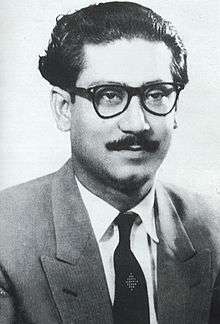 Sheikh Mujibur Rahman—founding father of Bangladesh, its first President who later served as the prime minister of his country.
Sheikh Mujibur Rahman—founding father of Bangladesh, its first President who later served as the prime minister of his country.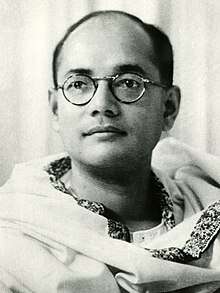 Subhas Chandra Bose—Indian nationalist and freedom fighter
Subhas Chandra Bose—Indian nationalist and freedom fighter.jpg) Swami Vivekananda—Indian Hindu monk
Swami Vivekananda—Indian Hindu monk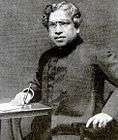 Jagadish Chandra Bose—preeminent scientist, fellow of the Royal Society
Jagadish Chandra Bose—preeminent scientist, fellow of the Royal Society Satyendra Nath Bose was one of the pioneers of quantum mechanics
Satyendra Nath Bose was one of the pioneers of quantum mechanics- Sir Chandrasekhara Venkata Raman—Nobel laureate in physics
.jpg) Satyajit Ray—Indian filmmaker, screenwriter
Satyajit Ray—Indian filmmaker, screenwriter.jpg) Amartya Sen—Nobel laureate in economics
Amartya Sen—Nobel laureate in economics.jpg) Abhijit Banerjee—Nobel laureate in economics
Abhijit Banerjee—Nobel laureate in economics Binay Ranjan Sen—former director-general, Food and Agriculture Organization
Binay Ranjan Sen—former director-general, Food and Agriculture Organization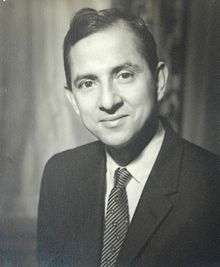 Bishweshwar Prasad Koirala—first democratically elected prime minister of Nepal
Bishweshwar Prasad Koirala—first democratically elected prime minister of Nepal Pranab Mukherjee—former president of India (2012 - 2017)
Pranab Mukherjee—former president of India (2012 - 2017) M. Hamid Ansari—former vice-president of India (2007–2017)
M. Hamid Ansari—former vice-president of India (2007–2017) Jyoti Basu—Longest serving elected Communist leader and chief minister, West Bengal, India
Jyoti Basu—Longest serving elected Communist leader and chief minister, West Bengal, India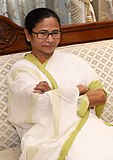 Mamata Banerjee—Chief Minister of West Bengal, India
Mamata Banerjee—Chief Minister of West Bengal, India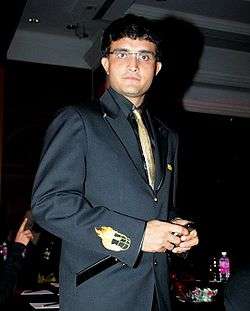 Sourav Ganguly—Indian Cricket Captain, 2000–2005; Current BCCI president
Sourav Ganguly—Indian Cricket Captain, 2000–2005; Current BCCI president Lakshmi Mittal—chairman & CEO of ArcelorMittal
Lakshmi Mittal—chairman & CEO of ArcelorMittal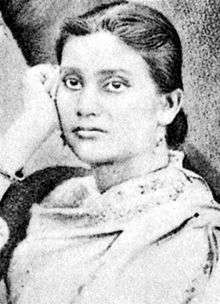 Kadambini Ganguly—first Indian and South Asian female physician and surgeon
Kadambini Ganguly—first Indian and South Asian female physician and surgeon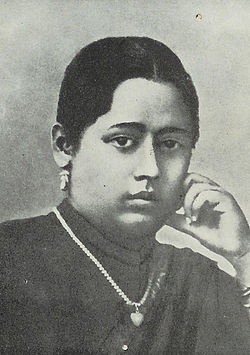 Chandramukhi Basu—first Indian and South Asian postgraduate and head of an undergraduate academic establishment.
Chandramukhi Basu—first Indian and South Asian postgraduate and head of an undergraduate academic establishment.
See also
References
- "Vice-Chancellors". www.caluniv.ac.in. Retrieved 13 November 2017.
- CU information brochure for MSc, BTech Retrieved 25 November 2011
- "University of Calcutta - Banglapedia". en.banglapedia.org. Retrieved 29 June 2020.
- "Foundation". www.caluniv.ac.in. Retrieved 29 June 2020.
- "Noteable Firsts". caluniv.ac.in. Retrieved 23 September 2019.
- Medical College, Kolkata Archived 18 February 2013 at Archive.today Official website of Calcutta Medical College. Retrieved 5 August 2012.
- History Of Bethune College Archived 13 October 2012 at the Wayback Machine bethunecollege.ac.in Official Site of Bethune College. Retrieved 5 August 2012
- "About Us – Government Science College, Jabalpur, MP". Retrieved 29 June 2020.
- "About the university". 8 August 2011. Archived from the original on 8 August 2011. Retrieved 29 June 2020.
- DelhiJanuary 24, India Today Web Desk New; November 12, 2017updated:; Ist, 2018 14:57. "University of Calcutta began its journey on this date". India Today. Retrieved 29 June 2020.CS1 maint: extra punctuation (link) CS1 maint: numeric names: authors list (link)
- "Notable Firsts". www.caluniv.ac.in. Retrieved 29 June 2020.
- "Genesis and Historical Overview of the University". University and its Campuses. University of Calcutta. Archived from the original on 21 March 2007. Retrieved 22 March 2007.
- "Wayback Machine". 21 March 2007. Archived from the original on 21 March 2007. Retrieved 29 June 2020.
- "Heritage Buildings". caluniv.ac.in. Retrieved 30 June 2020.
- "University of Calcutta | university, Kolkata, India". Encyclopedia Britannica. Retrieved 29 June 2020.
- Basu, Somdatta (27 April 2019). "Calcutta University to throw open its libraries to public | Kolkata News - Times of India". The Times of India. Archived from the original on 24 August 2019. Retrieved 24 August 2019.
- "The Story of Calcutta University – Kolkata360 – The Story of Kolkata". Retrieved 29 June 2020.
- Seals of the University : Changes over the Years Archived 22 February 2012 at the Wayback Machine caluniv.ac.in. Retrieved 5 August 2012
- "univ_campus1". 22 June 2012. Archived from the original on 22 June 2012. Retrieved 29 June 2020.
- "Campus_All". caluniv.ac.in. Retrieved 30 June 2020.
- "Campus Area". University and its Campuses. University of Calcutta. Archived from the original on 21 March 2007. Retrieved 11 April 2007.
- "Clg_strt_Campus". www.caluniv.ac.in. Retrieved 30 June 2020.
- "University College of Science, Technology & Agriculture". www.caluniv-ucsta.net. Retrieved 29 June 2020.
- University Campus Archived 22 June 2012 at the Wayback Machine caluniv.ac.in. Retrieved 12 August 2012
- "Rajabazar_Science_College_campus". caluniv.ac.in. Retrieved 30 June 2020.
- "Ballygunge_Science_College_Campus". caluniv.ac.in. Retrieved 30 June 2020.
- "Alipore_Campus". caluniv.ac.in. Retrieved 30 June 2020.
- "Calcutta University plans Technology campus". Other States: West Bengal. The Hindu. 16 January 2006. Retrieved 13 April 2007.
- "Tech-campus". www.caluniv.ac.in. Retrieved 6 June 2020.
- "Officers". caluniv.ac.in. Retrieved 1 July 2020.
- "budget_2016" (PDF). caluniv.ac.in. Retrieved 1 July 2020.
- "budget_2015" (PDF). caluniv.ac.in. 2015. Retrieved 1 July 2020.
- "Antidote to admission hit-and-miss". The Telegraph. 22 May 2012. Retrieved 1 June 2012.
- "Affiliated|Colleges". caluniv.ac.in. Retrieved 30 June 2020.
- "Departments & Centers". caluniv.ac.in. Retrieved 30 June 2020.
- "Down Memory | Colleges". caluniv.ac.in. Retrieved 30 June 2020.
- "Admission Notice for B.Ed. Course, 2019-2021" (PDF). caluniv.ac.in. Retrieved 1 July 2020.
- "Provisional list of Institutes for admission to Undergraduate Courses". wbjeeb.nic.in. Retrieved 1 July 2020.
- "Branches Seats". wbjeeb.nic.in. Retrieved 1 July 2020.
- "General Admission Rules for M.Tech. Courses w.e.f. 2019-2020" (PDF). caluniv-ucsta.net. Retrieved 1 July 2020.
- "Advertisement for Enrolment to Ph. D. Programme in Bengali Language & Literature for the Session 2019-20" (PDF). caluniv.ac.in. Retrieved 1 July 2020.
- "Course: Master in Business Administration (MBA) 2 year full-time Post-Graduate Course" (PDF). caluniv.ac.in. Retrieved 1 July 2020.
- "About CRNN". caluniv.ac.in. Retrieved 14 October 2018.
- Basu, Somdatta (27 April 2019). "Calcutta University to throw open its libraries to public | Kolkata News - Times of India". The Times of India. Archived from the original on 24 August 2019. Retrieved 24 August 2019.
- University library Archived 28 February 2019 at the Wayback Machine caluniv.ac.in. Retrieved 24 March 2013
- "University Press and Publications". caluniv.ac.in. Retrieved 1 July 2020.
- "University Campuses". caluniv.ac.in. Retrieved 1 July 2020.
- "The Calcutta Review". caluniv.ac.in. Retrieved 1 July 2020.
- "QS World University Rankings 2020". QS Quacquarelli Symonds Limited. 2019. Retrieved 1 October 2019.
- "QS Asia University Rankings 2020". QS Quacquarelli Symonds Limited. 2020.
- "QS BRICS University Rankings 2019". QS Quacquarelli Symonds Limited. 2018.
- "National Institutional Ranking Framework 2020 (Overall)". National Institutional Ranking Framework. Ministry of Education. 11 June 2020.
- "National Institutional Ranking Framework 2020 (Universities)". National Institutional Ranking Framework. Ministry of Education. 11 June 2020.
- "The Week India University Rankings 2019". The Week. 18 May 2019. Retrieved 9 June 2020.
- "Outlook India University Rankings 2019". The Outlook. 18 July 2019. Retrieved 10 June 2020.
- "CU makes the highest grade". The Telegraph. 6 January 2010. Archived from the original on 24 October 2012. Retrieved 10 August 2020.
- "CU gets "Potential for Excellence" tag of University Grants Commission". Cities.expressindia.com. 25 November 2010. Archived from the original on 21 November 2011. Retrieved 7 March 2011.
- "University Grants commission ::Universities (UPE)". www.ugc.ac.in. Retrieved 12 August 2020.
- "Calcutta University features at 3rd spot on India Today Universities Rankings 2012". 18 May 2012. Retrieved 10 August 2020.
- "University Grants commission ::Centre with Potential for Excellence in Particular Area". www.ugc.ac.in. Retrieved 12 August 2020.
- Manuscript Conservation Centres Archived 6 May 2012 at the Wayback Machine National Mission for Manuscripts.
- "CU makes the highest grade". The Telegraph. 14 August 2018. Archived from the original on 14 August 2018. Retrieved 30 June 2020.
- "CSIR-UGC National Eligibility Test" (PDF). currentscience. 25 August 2009. Retrieved 29 June 2020.
- "UNAI member list" (PDF). academicimpact.un.org. September 2019. Retrieved 29 June 2020.
- "Institute of Agricultural Science" (PDF). caluniv.ac.in. Retrieved 13 August 2020.
- "Horticulture". www.caluniv.ac.in. Retrieved 16 August 2020.
- "Department of Law". www.caluniv.ac.in. Retrieved 30 June 2020.
- University Halls and Hostels Archived 17 July 2012 at the Wayback Machine caluniv.ac.in. Retrieved 5 December 2012
- "Vice-Chancellors". www.caluniv.ac.in. Retrieved 29 June 2020.
- "Our Vice-Chancellors". University of Calcutta. Retrieved 19 July 2016.
- "Vice-Chancellors". www.caluniv.ac.in.
- About the university Archived 8 August 2011 at the Wayback Machine @ Official site, University of Calcutta. Retrieved 7 December 2011
- "Distinguished Alumni". caluniv.ac.in. Retrieved 30 June 2020.








